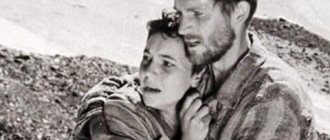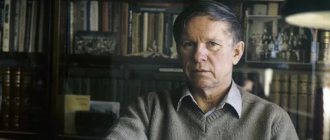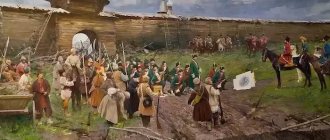In his book, Gogol raises the multifaceted and deep theme of art - the main purpose of the artist, as well as the selectivity and authenticity of talent. The essence and main theme of the story “Portrait” is that the border between true mastery and the pursuit of it is quite thin. A real gift must be separated from society, a person must live a hermit life, otherwise he will lose himself.
History of writing
The idea of writing came from Gogol in 1832. The history of the creation of “Portrait” is real facts from the creative life of the writer that deserve special attention:
- The story was one of the author's first works. The idea appeared after living in St. Petersburg in the 20s. XIX century. At this time, the writer was unable to enter the theater school, he lived in poverty and needed a means of subsistence, so he perceived the Northern capital as a cold and gloomy city in which there was no place for kindness and warmth.
- Readers guessed Alexander Ivanov, who worked on the religious painting “The Appearance of the Messiah,” as the prototype of the artist who painted the portrait.
- The first version of Gogol’s “Portrait” was not to the liking of critics, including Belinsky, so the writer significantly reworked the work and published an updated version in the Sovremennik publishing house in 1843. Today it can be called the main one.
Brief Analysis
Year of writing – first edition – 1833–1834, second edition – 1841–1842.
History of creation - in 1832 the idea of “Portrait” appeared, only in 1842 N.V. Gogol completely finished work on the story.
The theme is art, creativity.
The composition - the story is divided into two parts: the first part, including exposition, plot, development of action, climax and denouement, tells about the fate of the artist Chartkov, the second part, which is written using the technique of a story within a story, tells about the origin of the ominous portrait.
Genre : story.
The direction is realism, there are features of romanticism.
Genre and composition
The “Portrait” genre refers to fantastic realism. The writer strove for a realistic reflection of reality. The characters of the main characters, their quotes and actions look organic and real.
The story covers a short period of time, includes a small number of characters, and the story is full of many clarifications and details that emphasize the atmosphere of that time.
The work itself consists of several parts: the first tells about Chartkov, the second tells about the history of his purchase of the painting.
The composition of the story is classic:
- exposition, where the main character is described to the reader;
- the plot in which the picture appears;
- climax - the hero’s internal conflict is described here;
- the denouement where Chartkov dies;
- the finale, when the plot logically ends.
The philosophical meaning of the story “Portrait” lies in the conflict and confrontation of the individual with society and directly with himself. The difficult choice of an artist between the recognition of other people and real art.
Composition
The story “Portrait” is divided into 2 parts. The parts are complete, but interconnected. The connecting element is the portrait of a moneylender, bringing misfortune.
The first part tells about the life of Chartkov, an aspiring artist. The narrative is built from the episode of Chartkov’s purchase of the painting to the terrible death of the main character. That is, in this part there is an exposition associated with Chartkov’s former life, a plot associated with the purchase of a portrait, a development of action associated with Chartkov’s enrichment, a climax associated with the mental disorder of the protagonist, and a denouement associated with Chartkov’s death.
The second part talks about the ominous portrait that people are so eager to buy. The son of the artist who painted the portrait talks about the misfortunes this work of art brought. Compositionally, this technique can be assessed as a story within a story.
A compositional feature of the story is also that the images and parts are opposed to each other. Chartkov chooses the commercial path and fame, losing his talent and life, the father of the artist B. chooses true art, abandoning worldly life.
Contents and meaning of the name
The title “Portrait” contains the object that launched all the storylines of the work, influencing the fate of the main character. The writer immediately highlighted the main detail in the story, which combined two parts.
The meaning of the work “Portrait” is a description of society and all its vices. The book is about a poor artist. One day in the store he saw a portrait of an old man. The painting fascinated him, and he purchased it with his last money.
After returning home, he cannot shake off the feeling of anxiety. He is sure that the painting is watching him. At night, Chartkov dreamed that she came to life, and the old man began to count the money.
In the morning, the owner of the property demands payment for accommodation. The hero has nothing to burn with, but suddenly in the frame of the portrait he finds a package containing 1000 rubles. Chartkov began to have a bright streak. He paid off his debts, bought an apartment, a laudatory advertisement in one of the magazines, and soon receives an order.
He is painting a portrait of a rich woman, trying to do the job well. However, the customer demanded something else, so Chartkov painted a beautiful but soulless picture. All doubts disappeared after receiving the fee.
After a while he was already a popular artist, became a skilled but limited master who served rich people. One day Chartkov visits an exhibition and sees a painting of an angel painted by his old friend, who devoted his whole life to art, Chartkov realized that his works were monstrous.
He constantly works, wanting to return the lost gift, but he is no longer able to make something truly beautiful. Chartkov loses his mind , buys various masterpieces and destroys them. As a result, he dies. After a while, the ill-fated portrait of an old man is put up for auction, and the reader learns that a moneylender is drawn on the canvas.
The son of the author of the picture came here and told his father’s story. The artist worked with a moneylender who ruined many people. As he wrote, he felt how the devilish power began to grow stronger in the picture . He quarrels with his family, for some reason he hates everyone. Having determined the reason, he quits work and wants to destroy the creation, but his friend, who took away the canvas, did not allow him to do this. All owners of the painting died after that.
N.V. Gogol. "Portrait". Retelling the content with quotes from the text.
Waking up, Chartkov remembered the dream, thinking, if only he had at least part of this money. In his imagination, “the bundles unwrapped, the gold glittered, and wrapped again.” The owner and the policeman came, demanding payment for the apartment. The owner did not agree that Chartkov repay the debt with paintings, as the quarterly suggested, since he did not like the artist’s paintings. Suddenly everyone heard the clink of coins; the policeman pressed too hard on the picture, in the frame of which there was a bundle of money. Chartkov promised to pay.He began to look at the 1000 gold chervonets, joyful, and thought that now he could work quietly for three years. But first he must “dress in a fashionable tailcoat, break his fast after a long fast, rent himself a nice apartment, go that same hour to the theater, to the pastry shop, to ... and so on - and he, having grabbed the money, was already on the street.”
Chartkov dressed up, rented a rich apartment, took a ride in a carriage. He met the old professor, but pretended not to notice him . He wanted to show his talent to the whole world , he already heard the words: “What a strong talent Chartkov has!” He ordered an article in the newspaper, which appeared under the title “On the extraordinary talents of Chartkov,” it was written: “Glorify yourself and us. We know how to appreciate you."
Literally the next day a lady came to order a portrait of her daughter. The artist already had a premonition of how he would create the portrait. However, the lady began to impose conditions: what her daughter should be depicted in, in what setting. The next day he continued his work, the lady again almost telling him what should not be depicted in the picture. “With sadness, he began to erase what his brush had forced to appear on the canvas. Many almost imperceptible features have disappeared, and along with them the similarity has partially disappeared.”
In the end, he created the portrait that the lady wanted. “The artist was rewarded with everything: a smile, money, a compliment, a sincere handshake, an invitation to dinner; in a word, he received a thousand flattering awards.”
Orders poured in. The artist fulfilled all the clients' wishes. “At first, the artist was challenged by such demands: all this had to be figured out, thought through, and yet very little time was given. Finally he figured out what the matter was, and there was no difficulty at all .”
Chartkov became a fashionable painter , he was invited to the richest houses. “ He now spoke sharply about artists and art: he argued that too much dignity had already been attributed to former artists.”
“No, I... I confess, I don’t recognize as art the fact that line after line is molded; This is a craft, not an art.”
Over time, he was already tired of writing , he only made sketches of the head, and the rest was completed by his students. boring for him . “His brush grew cold and dull , and he insensitively enclosed himself in monotonous, definite, long-worn forms .” Over time , even ordinary advantages were not visible on his canvases . Those who knew him before wondered where his talent had disappeared.
Chartkov began to get fat, in the newspapers he was called “our venerable Andrei Petrovich,” “our honored Andrei Petrovich.”
“Glory cannot give pleasure to those who stole it and did not deserve it ; it produces constant awe only in those worthy of it. And therefore all his feelings and impulses turned to gold. Gold became his passion, ideal, fear, pleasure, goal .”
But one day Chartkov was invited to an exhibition at the Academy of Arts to evaluate the work of a Russian artist who improved his skills in Italy, devoting everything to art.
Chartkov saw: “ pure, immaculate, beautiful , like a bride, stood before him the artist’s work.” Tears welled up in my eyes, a sob burst out in response to a question about the evaluation of the work. Chartkov ran out of the hall. I ran to the workshop. He realized with despair that he had wasted his talent. " God! and destroy so mercilessly the best years of your youth ; to destroy, to extinguish the spark of fire, perhaps, which was warming in the chest, perhaps, would now develop in greatness and beauty, perhaps, also tearing out tears of amazement and gratitude! And destroy it all, destroy it without any pity!”
He tried to create something, but he couldn't anymore. “...how mercilessly and ungratefully everything that came out from under his brush was!” Chartkov began to look at his works, written in his youth, and realized that he had talent .
He began to buy up all the talented paintings, emptied his bags of money, and spent the money on buying paintings. In the end, the hero went crazy and died.
Description of the characters
Each part of the story has its own main character. In the first he is Chartkov, and in the second he is a moneylender. System of images in the work:
- Chartkov. A carefree and talented young man who goes from a gifted but poor painter who serves art to a famous but mediocre artist who cares only about money. The portrait developed all the negative qualities in the hero: spiritual weakness, greed and ambition. He has become a “little man” who lacks the strength to develop talent. He becomes a victim of the gloomy city.
- Old man. A moneylender unloved by many people who died before the start of the work. This is a greedy and smart person. The money he gave brought only grief. It is a symbol of all the vices of people.
- Description of St. Petersburg. A city of greedy people, where everyone lives by deception. Here everyone only needs money, so everyone is ready to sell themselves for financial well-being and popularity in society.
- Author of the painting. A talented artist, a believer who gave his life to art. He agreed to paint a portrait and then draw a biblical hero. When he realized the impact of the painting, he immediately quit his job, regardless of the money. Then he lived in a monastery, praying for forgiveness of sin. This was the only way he was able to regain the purity of his soul.
- Portrait image. The painting had a hypnotic effect and terrified its owners. The eyes of the drawn moneylender watching over his victims are especially vividly described. They contain the mysterious power of the canvas.
Subject of the work
The themes of “Portrait” are close to all people who are involved in art. They affect all areas of life and are still relevant today:
- Craft - in the image of the main character, the writer shows a craftsman, he works for money and fame, and not to change the world for the better. He gave up real art for material well-being, gained wealth and popularity, but he can never become truly happy. This man doomed himself to spiritual death and disappointment. The writer’s view of art is determined by his personal biography: he was never able to start a family, but devoted his whole life to creativity.
- Art. According to Gogol, a creative person who has chosen the path of serving creativity takes on a huge burden. This man has great power that can change people's souls. Often the creator himself never finds happiness for himself.
- Petersburg is portrayed by the writer as a gloomy city where there is no place for pity, and society is subject to various vices.
- The fate of the artist - the writer showed that a creator can have several paths: the pursuit of money or the service of art. The author chose the path of a true artist, despite the misfortunes that await people on it.
- Faith. Religion allows the creator to purify the soul to create masterpieces.
- Small man. The main character is a victim of the city, and not the master of his life. He is weak and dependent on the opinion of society, even losing his mind at the end of the work. His path to his dream ends in disappointment, because false values have led him into an abyss from which he cannot find a way out.
Problems of the story
The problems in the work are also significant for understanding the book. They show the reader the society of Russia in the 19th century through the eyes of a writer:
- Greed. According to Gogol, money is the main cause of the evil that occurs. Having chased financial well-being and succumbed to various temptations, people can no longer find a way back. They are doomed to gradually sink into the abyss.
- Good and evil - evil in the work is described in the image of a portrait of an old man. According to the writer, greed is the worst sin of man. This is what overpowered Chartkov, killed the bright feeling in him and, as a result, led to such a sad ending. At the end, the portrait disappears, the writer is trying to convey that the struggle between good and evil is not over yet.
- Talent and its loss - the writer is trying to show that it can be found with great difficulty, but if you just stumble a little, it will be lost forever.
- Vanity - Chartkov, having achieved fame, became proud and felt like a real artist.
main idea
Gogol shows the soullessness, as well as all the vices of the people of that time, the general decay that the writer felt while living in St. Petersburg. To this he contrasts the purity of real art and the power of the Christian faith. This is the main idea of the work.
Also, the narrative is the author’s reflection on what an artist should really be like. He shows that serving art is a difficult and thorny path, but only by following it can one truly change the world.
The work teaches us to despise greed. He says that you need to think not only about the body, but also about the state of mind. These are the moral lessons of the story. The author has shown art that can have a great influence on people, and talks about the price an artist must pay to gain this power.
History of creation
In 1832, N.V. Gogol came up with the idea of creating a “Portrait”; in 1833, the writer began working on the work, and already in 1834 he finished it. The story was first published as part of the collection “Arabesques” in 1835.
After numerous negative critical articles, N.V. Gogol decides to change his story: the plot, the name of the main character, the style of presentation, many dialogues. The revision took the writer a year: from 1841 to 1842. The edited work was published in the famous magazine Sovremennik with a note that this story is not the original.
Check out what else we have:
for the most rational -
Summary of “Portrait”
for the busiest -
Reader's diary "Portrait"






